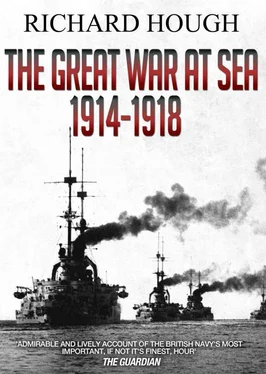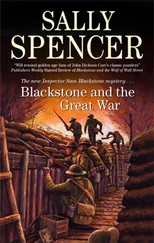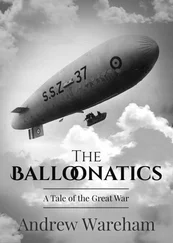The Lords Commissioners of the Admiralty had long since established a principle that experiment and innovation must be avoided. Others could be inventive if they wished. Britain might follow in due course if she thought fit. This principle applied to all manner of advances, most conspicuously to the acceptance of steam propulsion and the end of masts and yards. When the battleship Inflexible was commissioned in 1881 she was the wonder ship of her day, with the biggest (16-inch) guns in the service and armour-plate of 24 inches, a thickness never exceeded. She could steam at almost 15 knots. But she was a sort of nineteenth-century hybrid, linking the eighteenth and twentieth centuries. While she enjoyed the unique advantage of electric light she was also fully rigged, and as much time and skill were devoted to hoisting sail and taking in a reef as if she had been Sir John Jervis’s flagship at St Vincent. Traditionalism in the Royal Navy had been strengthened after the introduction of pioneering breech-loading guns in 1860 and their hasty abandonment after several accidents. Twenty years were to pass, when the breech-loader was long since established in foreign navies, before the Admiralty would countenance their return.
The emphasis was on smartness, speed in hoisting sail, precise conformity to signal-book diagrams in fleet drills, pride in pulling races and inter-ship boxing and tug o’wars. Admiral ‘Pompo’ Heneage, who was born three years earlier than Queen Victoria and retired three years before she died, was the complete Victorian naval officer, but by no means the most eccentric nor exceptional in his concern for a ship’s cleanliness or smartness. ‘When inspecting ships he always wore white kid gloves,’ according to one naval writer, ‘and his coxswain followed him with a dozen spare pairs… He liked to put his hands on the tops of pipes running over his head, or into the most inaccessible nooks and crannies. If one speck of dust appeared on the immaculate gloves, he would turn to the Commander waving two fingers. “Dis is not de dirt of days,” he would observe, “nor de dirt of veeks, nor de dirt of months. It is de dirt of ages. Coxswain, gif me a clean pair of gloves.”’ (4)
Practice ‘shoots’ were not considered of first priority by the commanders-in-chief nor by their captains. The shine on the decorated tampion, which closed off like a cork the guns’ barrels, was more important; and it was not unknown for the meagre ration of practice ammunition to be tossed overboard for fear that gun-firing might spoil the brasswork.
During this long period of decay, a handful of exceptionally talented officers somehow achieved positions of influence ashore and afloat. Among them were Philip Colomb, a questioning intellectual who wrote provocatively for service journals, and Admiral Sir Frederick Richards, a great reformer and administrator.
Far above them all as an administrator, reformer, inspirer, persuader, manipulator, charmer, and politician was John Arbuthnot Fisher. Fisher, the counterpart and chief adversary of Alfred von Tirpitz, did more than any single officer to drag the Royal Navy out of its nineteenth-century sloth, inefficiency, and drowsiness, and make it fit to stand up to the superb force Tirpitz created.
In his years of greatness a friend of kings and princes, politicians and newspaper proprietors, ‘Jacky’ Fisher entered the Navy in the 1850s, ‘penniless, friendless and forlorn’ as he later wrote. His family was certainly without power or influence, his father being an ex-army officer turned tea-planter of mixed fortunes in Ceylon. Fisher never saw him after the age of six, when he was sent to England to live with an uncle. It seems likely that Fisher’s exceptional qualities of intellect and moral and physical courage were inherited from his mother, who is described as having a ‘powerful mind, organizing capacity and taste for power’. (5)
Within twenty years Fisher had made his mark as an ‘apostle of progress’ with a special interest in torpedoes, mines, gunnery, and advanced machinery like the water-tube boiler and the turbine.
From captain of the Navy’s gunnery school, Fisher became Director of Naval Ordnance and Torpedoes in 1886, a department he found in a state of chaos and confusion. Within less than five years he had totally reorganized it, and successfully withdrawn from the Army its remarkably anomalous responsibility for naval guns. This performance was a preview in miniature of his future period as First Sea Lord. Fisher gathered about him a group of ambitious and patriotic officers attracted by his dynamism, self-assurance and extreme style: they were the cream of the Navy’s intellect, soon to be known as members of the ‘Fishpond’. And heaven help any non-member (he called them ‘the syndicate of discontent’) who opposed Fisher’s policies! Fisher inevitably made enemies with every reform but it was not necessary for him to have made as many as he did, or to be so unforgiving. Nonetheless it can fairly be said that when Fisher was appointed First Sea Lord in October I 904, six months after the signature of the Entente Cordiale , the Royal Navy’s course towards decay was reversed.
Fisher recognized, ahead of many politicians, the deadly danger emerging from across the North Sea. He also knew that the men who would one day have to face it must be of the highest quality. With this in mind he transformed recruitment, manning, and status in the Navy. He introduced schemes to encourage promotion from the lower deck and at the same time abolished fees at naval colleges through which only the well-off had once passed. He introduced a nucleus crews system of reserves, based on French practice, and greatly improved the standing of the once-despised engineer officers.
All this was recognized by his followers in the service to be of inestimable value. Fisher’s matériel reforms were more conspicuous. Ignoring the cries of fury from deprived commanders and far-flung diplomats, Fisher brought home numerous ships, most of which ‘could neither fight nor run away’ (as Fisher expressed it) and were scrapped. Even the Mediterranean Fleet was reduced to a shadow of the great fleet he had commanded from 1899 to 1902. Through influential friends and through his press contacts, Fisher concentrated the nation’s eye on Germany, and Germany alone, as the threat to Britain’s dominance at sea. The people loved it, and the Navy League flourished. By economies as ruthless as his reforms, Fisher reduced the Navy Estimates three years running. The Liberals loved him for that.
Above all else, Fisher gave the nation the dreadnought. This statement requires qualifying for it can also be argued that the all-big-gun ship was inevitably the final stage in the design of the old ship-of-the-line. In the nineteenth century the battleship had passed through numerous developments, from the three-decker wooden walls, little improved from the mid-eighteenth century, to mixed sail and steam propulsion, to the ‘mastless’ ironclad. Guns had developed from smooth-bore 68-pounders firing solid shot, to the 16-inch, rifted, breech-loading guns of the Inflexible .
As defence against the explosive charge of these massive shells, armour-plate had grown in thickness and resistance until (again in the Inflexible ) it was responsible for 27.5 per cent of the ship’s total displacement. By the end of the century, a typical modern first-class battleship was armed with four guns of 12-inch calibre in two turrets fore and aft, and a mixed battery of medium-calibre guns, from 6-inch to 9.2-inch.
By this time there was a growing consciousness of the threat of the torpedo and the mine. Cheap, nippy little torpedo boats, capable of speeds twice that of a battleship, could race in and send to the bottom a man o’war costing a million pounds and taking four years to build. This very real threat led to radical alterations in the design and defences of the battleship and to radical new thinking on tactics. Massive and cumbersome nets were carried and hoisted out like a steel crinoline by battleships at anchor. Battleships bristled with anti-torpedo boat light guns. It was deemed prudent to extend greatly the range at which lines of battleships fought one another.
Читать дальше












